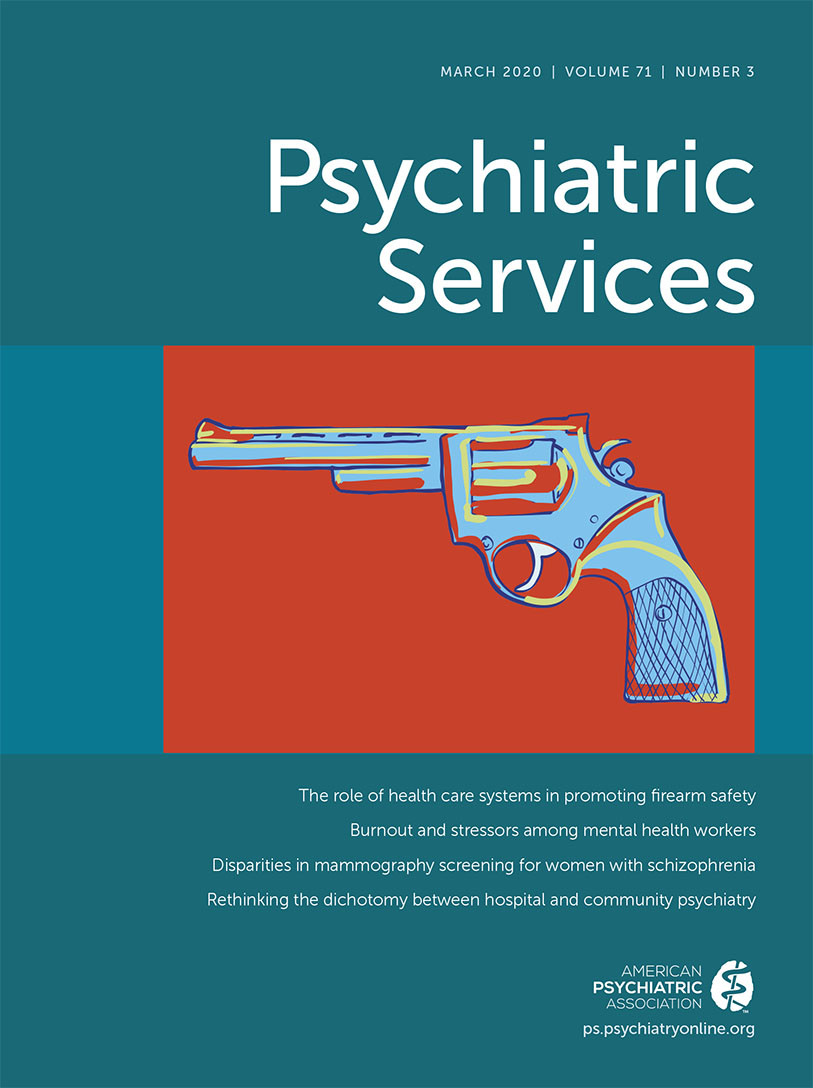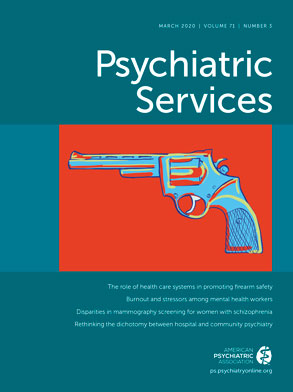Suicide is the 10th leading cause of death in the United States and the second leading cause of death among those ages 10–34 years (
1). In 2017, half of the 47,173 suicides that occurred in the United States were firearm related. Nationally, health care systems are important drivers of suicide prevention efforts. As such, in 2018, the National Academies of Sciences, Engineering, and Medicine convened a workshop to highlight the role of health care systems in preventing firearm injuries and deaths, including firearm-related suicides (
2). To effectively promote firearm-related lethal-means safety (LMS) as a suicide prevention strategy, health care systems will face several challenges. These challenges include training staff, developing and implementing evidence-based interventions, navigating firearm owners’ firearm-related risk perceptions, and managing sensitive firearm-related patient information.
Training Staff
Although some firearm-related counseling is already occurring in clinical settings, the quality, prevalence, and impact of that counseling are unclear. This is in part due to a lack of standardized, evidence-informed clinical training programs on LMS. Implementing an initiative to promote firearm safety within a health care system would require significant training resources. For clinical staff, training should include information regarding firearm function and terminology, strategies to promote safety (e.g., firearm locking devices), and the reasoning and data underlying LMS recommendations. Training in motivational interviewing and communication strategies that facilitate shared decision making may also be necessary for clinical staff charged with motivating behavior change in the exam room. Expected skill sets will also need to be tailored to various clinical settings and patient-risk groups (e.g., high, acute suicide risk versus low, chronic risk). For example, expectations of what constitutes appropriate LMS counseling are likely to differ for an emergency department clinician in comparison with an outpatient mental health clinician who works within the context of an established patient-clinician relationship. Successfully promoting firearm safety may be contingent in part on whether patients perceive clinicians as credible, informed messengers. Many U.S. adults agree that firearm-related conversations (
3), including conversations about suicide prevention (
4–
6), are appropriate in clinical settings. However, according to a 2016 study, only 19% of U.S. firearm owners agree that physicians would be good or excellent messengers to teach about firearm safety (physicians edged out celebrities by only 8%) (
7). In comparison, 77% of firearm owners agreed that law enforcement personnel would be good or excellent messengers. The acceptability of firearm-related interventions in clinical settings is also likely to differ between adult and pediatric settings, in which safety discussions are commonplace (e.g., car seat recommendations, poisoning prevention) (
4). Issues contributing to perceptions about staff credibility are likely multifactorial. However, providing staff with firearm-specific knowledge and patient-centered communication strategies may help improve perceptions regarding their role in preventing firearm suicides.
Developing and Implementing Clinical Interventions
Developing and implementing evidence-based firearm safety interventions that are tailored to diverse clinical settings and patient-risk groups is an important next step. Most prior firearm safety interventions have focused on preventing unintentional firearm injuries among families, children, and adolescents, rather than on preventing suicide among adults (
8,
9). Interventions have not been specifically tested among important subpopulations, such as veterans. Among this cohort, nearly 50% own a firearm (in comparison with 20% of U.S. adults) and two-thirds of suicides are firearm related (
10,
11). Prior interventions have relied mostly on recommending safe firearm storage (e.g., using a trigger lock) rather than removal of firearms from the household (
8). Promoting the safe storage of firearms while keeping them in the home is a reasonable evidence-based approach to preventing injuries among children. The effectiveness of this strategy in preventing suicide among adult firearm owners has yet to be rigorously evaluated.
Most clinic-based LMS efforts among adults are delivered as secondary preventive actions. That is, efforts to promote LMS are initiated after an individual has been identified as having elevated suicide risk. Given that individuals known to be at risk account for a relatively small proportion of the at-risk population, an important next step will be to develop firearm-related LMS interventions for those who have elevated suicide risk that has yet to be identified (i.e., primary prevention). Determining how to most effectively discuss firearm-related risk among members of the general population will be of paramount importance but uniquely challenging.
Risk Perceptions
Risk perceptions are strong predictors of human behavior. According to the health belief model, behavior change (in this case, increasing firearm safety) is dependent on individuals’ perceptions about their susceptibility to a negative outcome (e.g., firearm suicide) and the likelihood that behavior change will help avert that outcome. It is unclear to what extent and under what circumstances firearm owners consider access to firearms a risk factor for suicidal behavior. For example, only 6% of U.S. adults believe that having a firearm in the home increases suicide risk (
12,
13). Interestingly, when asked what steps they might take to prevent suicide by an at-risk household member, 82% of that same sample reported that they would limit that individual’s access to firearms (
14). Efforts to promote firearm safety as a suicide prevention strategy are further complicated by perceptions about the risk of adopting safe firearm-storage practices. For example, two-thirds of U.S. adult firearm owners keep firearms for personal or household protection, and those who own firearms for protection are more likely to store firearms unsafely and to believe that safely stored firearms are less useful in self-defense scenarios (
10,
14–
16). Future research could be useful in improving our understanding of factors driving some individuals’ needs for protection (e.g., prior victimization or trauma, actual versus perceived threats) and in determining whether and to what extent firearms are truly protective. It will then be critical to identify how best to incorporate into interventions communication strategies that help patients balance the risks and benefits of adopting firearm-related LMS practices.
Recommendations
Health care systems are important drivers of suicide prevention initiatives and have a key role and critical opportunity in promoting firearm-related LMS. Given that 51% of all suicides are firearm related and that 20% of U.S. adults own a firearm (
1,
10,
16), initiatives aimed at promoting firearm safety as a suicide prevention measure will require significant resources. The following recommendations may be key areas for future work.
First, health care systems should develop a comprehensive set of evidence-informed LMS training materials that provides clinical staff with relevant background knowledge and facilitates training in communication strategies. Training plans should be standardized in terms of general content, yet flexible and tailored to meet the needs of clinical staff, who have varying levels of training, responsibility, and available resources for addressing LMS among various at-risk groups with access to firearms. Health care systems should evaluate whether providing such training affects provider and patient behaviors and should modify training materials and plans accordingly.
Second, health care systems should prioritize the development and implementation of firearm safety interventions tailored to diverse clinical settings and patient-risk groups. Determining whether increased firearm safety within the household (as opposed to the absence of a firearm) reduces suicide risk among adults is paramount.
Third, support for research that improves understanding of firearm-related risk perceptions is needed. This work will be imperative for developing messaging and communication strategies that enable clinicians to facilitate discussions about balancing the short- and long-term risks and benefits of firearm access.
Fourth, health care systems should develop and disseminate a plan outlining firearm-related data collection and management procedures. It is essential to offer patients and clinical staff a clear description of what clinicians and health care systems intend to do with firearm-related data, the implications of providing that information during clinical encounters, and under what rare circumstances that information may affect firearm ownership rights.
Fifth, systems should develop infrastructure to facilitate stakeholder engagement across a wide range of firearm-related clinical and research endeavors. Doing so will help increase the cultural competency of a health care system’s efforts and help focus materials and interventions on patient needs.
Sixth, continued partnerships with firearm owners, gun shops, shooting ranges, and firearm advocacy organizations are recommended. Leveraging the expertise of this community, including patients and staff, could prove invaluable in informing training and clinical materials that support competent and credible firearm-related discussions in clinical settings.
Seventh, health care systems and academic centers serve a critical role within the U.S. public health framework via involvement in research, work in community-based health promotion, and support for staff who work across sectors. Health care systems should leverage this role to increase their effectiveness in preventing firearm-related suicides by continuing to support programs that increase firearm safety within communities and reduce stigma associated with adopting firearm-related LMS practices.

